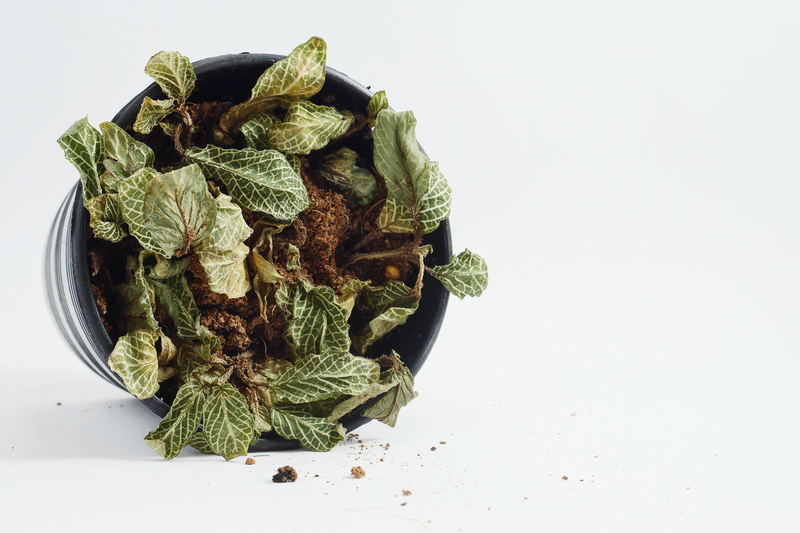Explore Amazing Hedge Trimming Shapes
Posted on 29/06/2025
Explore Amazing Hedge Trimming Shapes: Transform Your Garden with Creative Designs
If you're passionate about gardening and landscaping, you already know how much hedges contribute to the beauty and structure of an outdoor space. Hedge trimming shapes do more than just tidy up your green spaces - they can turn ordinary shrubbery into living works of art. Whether you want a classic English garden, whimsical topiaries, or something modern and sculptural, there's a hedge trimming shape for every vision. In this comprehensive guide, we'll explore amazing hedge trimming shapes that can elevate your garden and inspire creativity.

Why Invest in Creative Hedge Trimming?
Transforming plain hedges into sculpted masterpieces offers multiple benefits:
- Boosts curb appeal: Unique hedge shapes instantly make any property more attractive.
- Personalizes your garden: Express your style with one-of-a-kind hedge designs.
- Adds structure: Trimmed hedges define spaces, create privacy walls, or guide pathways.
- Encourages plant health: Regular, careful trimming thickens growth and prevents disease.
- Provides wildlife habitat: Many crafted hedge shapes offer shelter for birds and pollinators.
With these hedge trimming shape ideas, your landscape will become a conversation starter and a reflection of your creativity.
Popular Hedge Trimming Shapes to Try
1. Classic Geometric Hedge Shapes
Traditional gardens often favor geometric hedge trimming shapes, which evoke a sense of order and elegance.
- Rectangular: The classic box or rectangle is neat and formal, ideal for borders and property lines.
- Square: Slightly higher than rectangle, these give a modern, minimalistic feel.
- Round/Spherical: Popular in both formal and informal gardens, round shapes soften the landscape and are often clustered together for dramatic effect.
- Pyramid: A bold, eye-catching trim that's perfect for anchoring corners or highlighting entrances.
- Conical: Think of Christmas tree or obelisk-inspired hedges -- a dynamic shape that stands out, especially when grouped.
2. Artistic Topiary Hedge Trimming
Topiary is the ancient art of sculpting living shrubs into imaginative forms. With patience and practice, you can create:
- Animals: Lions, birds, rabbits, and elephants bring playful whimsy to any garden. Animal-shaped hedges are a hit with children and guests alike.
- Spirals: Spiraling designs are both modern and elegant, often placed along pathways or entrances for maximum impact.
- Architectural forms: Arches, columns, and domes add a classical vibe and can even form entrances or passageways within the hedge itself.
- Abstract art: For a contemporary garden, experiment with asymmetrical or abstract shapes for a unique statement.
3. Natural and Free-form Hedge Shapes
For those preferring a more organic look, naturalistic or free-form hedge trimming styles mimic the randomness of nature while remaining intentional:
- Cloud pruning: This technique creates billowing, rounded clusters reminiscent of clouds, often seen in Japanese gardens.
- Wave hedges: Undulating curves that flow gracefully, especially along larger boundaries.
- Mixed height: Varying hedge heights within the same line for a dynamic, layered effect.
- Loose screens: Less dense, more airy hedges that provide privacy without complete enclosure.
How to Choose the Best Hedge Shape for Your Garden
When selecting hedge trimming shapes for your landscape, consider the following:
- Garden style: Formal landscapes benefit from geometric shapes; cottage or wild gardens may suit free-form designs.
- Plant species: Certain shrubs, like boxwood or yew, respond well to intricate shaping, while laurel and privet are better for simple forms.
- Growth pattern: Fast-growing hedges require frequent trimming, while slow-growing varieties are low-maintenance and ideal for detailed shapes.
- Purpose: Decide if you're seeking privacy, border definition, or a decorative focal point.
- Skill level: Beginners might start with basic spheres or cubes; experienced gardeners can try topiary or abstract art shapes.
Essential Tools & Materials for Creative Hedge Trimming
To create amazing hedge trimming shapes, equip yourself with the following essentials:
- Sharp hedge shears or electric trimmers
- Bypass pruners for detailed work
- String, stakes, or wire frames for guiding complex designs
- Protective gloves and eye gear
- Measuring tape or stick for accuracy
- Topiary forms or templates for beginners
Remember to always clean your tools between uses to avoid introducing disease.
Tips for Maintaining Unique Hedge Shapes
Shaping your hedges into creative forms requires more than a single trim. Keep these key tips in mind:
- Train young hedges: Start shaping early when stems are flexible and growth is vigorous.
- Trim regularly: Most shapes need 2-3 trims per growing season; frequent light trims are better than drastic cuts.
- Work with the plant's natural shape: Forcing a hedge too far from its natural form can result in stress, disease, or poor growth.
- Maintain symmetry: Step back often and view the hedge from all angles to ensure evenness.
- Don't forget the base: Trim the bottom wider than the top so lower branches stay healthy and green.
- Feed and water consistently: Well-nourished hedges retain their lush energy for easy shaping.
Inspiring Hedge Trimming Ideas from Around the World
The tradition of hedge shaping and topiary can be traced through many cultures. Here are some global influences to motivate your own projects:
European Formal Gardens
English and French chateaux gardens are famous for their symmetrical topiaries: spirals, balls, cones and elaborate knot gardens. Walk through the grounds of Versailles or an English manor, and you'll find intricate maze hedges, geometric parterres, and shaped yews lining dramatic avenues.
Japanese Cloud Hedges
Japanese garden design emphasizes subtlety. The cloud pruning style (Niwaki) transforms shrubs into smooth, billowing forms that evoke the gentle flow of clouds and water -- peaceful, meditative, and deeply connected to nature.
Modern Sculptural Gardens
Contemporary gardens in Australia, America, and beyond often feature abstract or themed hedge designs. Spirals flanking minimalist walkways, undulating waves along fences, and even living garden sculptures that double as functional garden art are all possible in today's landscapes.
Best Hedge Species for Shaping
Not all shrubs are created equal when it comes to hedge trimming shapes. If you're determined to master creative forms, consider these popular choices:
- Boxwood (Buxus): Renowned for small leaves, dense growth, and resilience--ideal for detailed shapes and topiary.
- Yew (Taxus): A classic option, slow growing but very hardy and easily shaped into all forms from cones to complex animals.
- Privet (Ligustrum): Fast-growing and flexible; perfect for both formal and free-form shapes.
- Laurel (Prunus): Best for larger, less intricate forms like waves or high screens.
- Holly (Ilex): Shiny foliage and dense habit suit both balls and cubes.
- Pittosporum, Photinia, and Euonymus: These can also be encouraged into interesting shapes with patience.
Step-By-Step Guide: Creating Your First Creative Hedge Shape
If you want to start your journey with amazing hedge trimming shapes, begin with a simple sphere. Here's how:
- Select the right shrub: Boxwood or yew are perfect for beginners.
- Visualize: Imagine or lightly mark the sphere shape onto the bush with string or chalk.
- Start from the top: Using sharp shears, trim the uppermost point to begin forming a dome.
- Work down and around: Move around the plant, cutting evenly to maintain symmetry. Step back often to check your progress.
- Shape the sides: Gradually round the sides, trimming little by little to preserve the natural density.
- Refine and finish: Use smaller pruners for detail, ensuring the sphere is smooth and even.
- Maintain: Repeat light trimming every few weeks during the growing season for neatness.
Remember, patience and practice are the keys to a truly fantastic hedge shape.
Common Mistakes to Avoid
Even experienced gardeners sometimes encounter challenges with creative hedge shapes. Here are frequent issues to watch out for:
- Pruning too much at once: Removing too much foliage can stress the plant and leave gaps.
- Neglecting the bottom growth: If light cannot reach the lower branches, they may thin and leave your hedge looking bare at the bottom.
- Using dull tools: This leads to ragged cuts prone to disease.
- Shaping at the wrong time: Trim in late spring or early summer to avoid frost damage and maximize regrowth.
- Attempting advanced shapes too early: Build confidence by mastering basic forms first.

Showcasing Your Creative Hedge Designs
Once your amazing hedge shapes are established, show them off! Here are ways to highlight your handiwork:
- Lighting: Use garden lights to cast dramatic shadows at night.
- Framing views: Align shapes as focal points from windows or benches.
- Thematic arrangements: Group shapes according to style (e.g., a chessboard of cubes and spheres, or a line of spirals).
- Complement with companion plants: Underplant with low perennials or colorful flowers to set off the green shapes.
Conclusion: Your Garden as a Living Canvas
Exploring amazing hedge trimming shapes is an exciting way to personalize and elevate your garden. From simple geometric forms to complex animal topiaries, the only limits are your imagination and patience. As you hone your skills, each trim becomes an artistic act, adding both value and wonder to your landscape.
Ready to transform your outdoor space into a masterpiece? Start experimenting with your favorite hedge trimming designs and garden shapes today--your perfect garden awaits, shaped by your own hands. Happy trimming!



